Membrane Processing in the Sustainable Production of Low-Sugar Apple-Cranberry Cloudy Juice
Abstract
1. Introduction
2. Materials and Methods
2.1. Materials
2.2. Ultrafiltration and Diafiltration
2.3. Analytical Methods
2.4. Calculation of Membrane Performance
2.5. Statistical Methods
3. Results
3.1. Ultrafiltration and Diafiltration Processing
3.2. Characterization of Permeates and Retentates
3.2.1. Physicochemical Properties
3.2.2. FTIR
3.3. Selectivity of Ultrafiltration and Diafiltration
3.4. A Glass of Juice
3.5. PCA and HCA Analysis
4. Conclusions
Author Contributions
Funding
Conflicts of Interest
References
- Basu, A.; Betts, N.M.; Ortiz, J.; Simmons, B.; Wu, M.; Lyons, T.J. Low-energy cranberry juice decreases lipid oxidation and increases plasma antioxidant capacity in women with metabolic syndrome. Nutr. Res. 2011, 31, 190–196. [Google Scholar] [CrossRef] [PubMed]
- Gill, J.M.R.; Sattar, N. Fruit juice: Just another sugary drink? Lancet Diabetes Endocrinol. 2014, 2, 444–446. [Google Scholar] [CrossRef]
- Regulation (EU) No 1169/2011 of the European Parliament and of the Council of 25 October 2011 on the Provision of Food Information to Consumers. Available online: https://eur-lex.europa.eu/legal-content/EN/ALL/?uri=CELEX%3A32011R1169 (accessed on 30 March 2018).
- Juarez-Enriquez, E.; Salmerón, I.; Gutierrez-Mendez, N.; Ortega-Rivas, E. Ultraviolet irradiation effect on apple juice bioactive compounds during shelf storage. Foods 2016, 5, 10. [Google Scholar] [CrossRef] [PubMed]
- Bondonno, N.P.; Bondonno, C.P.; Ward, N.C.; Hodgson, J.M.; Croft, K.D. The cardiovascular health benefits of apples: Whole fruit vs. isolated compounds. Trends Food Sci. Technol. 2017, 69, 243–256. [Google Scholar] [CrossRef]
- Muraki, I.; Imamura, F.; Manson, J.E.; Hu, F.B.; Willett, W.C. Fruit consumption and risk of type 2 diabetes: Results from three prospective longitudinal cohort studies. BMJ 2013, 347, f6935. [Google Scholar] [CrossRef] [PubMed]
- Teleszko, M.; Nowicka, P.; Wojdyło, A. Chemical, enzymatic and physical characteristic of cloudy apple juices. Agric. Food Sci. 2016, 25, 34–43. [Google Scholar]
- Bolton, R.P.; Heaton, K.W.; Burroughs, L.F. The role of dietary fiber in satiety, glucose, and insulin: Studies with fruit and fruit juice. Am. J. Clin. Nutr. 1981, 34, 211–217. [Google Scholar] [CrossRef] [PubMed]
- WHO. Healthy Diet. Fact Sheet N°394; WHO: Geneva, Switzerland, 2015. [Google Scholar]
- WHO. Sugars Intake for Adults and Children; WHO/NMH/NHD/15.2; WHO: Geneva, Switzerland, 2015. [Google Scholar]
- Echavarria, A.P.; Torras, C.; Pagan, J.; Ibarz, A. Fruit juice processing and membrane technology application. Food Eng. Rev. 2011, 3, 136–140. [Google Scholar] [CrossRef]
- Black, H.F.; Bray, R.G., Jr. Sugar Separation Form Juices and Product Thereof. U.S. Patent US5403604A, 4 April 1995. [Google Scholar]
- Lazarides, H.N. Food processing technology in a sustainable food supply chain. Procedia Food Sci. 2011, 1, 1918–1923. [Google Scholar] [CrossRef]
- Kumar, P.; Sharma, N.; Ranjan, R.; Kumar, S.; Bhat, Z.F.; Jeong, D.K. Perspective of membrane technology in dairy industry: A review. Asian-Aust. J. Anim. Sci. 2013, 26, 1347–1358. [Google Scholar] [CrossRef] [PubMed]
- Rabetafika, H.N.; Bchir, B.; Blecker, C.; Richel, A. Fractionation of apple by-products as source of new ingredients: Current situation and perspectives. Trends Food Sci. Technol. 2014, 40, 99–114. [Google Scholar] [CrossRef]
- He, Y.; Ji, Z.; Li, S. Effective clarification of apple juice using membrane filtration without enzyme and pasteurization pretreatment. Sep. Purif. Technol. 2002, 57, 366–373. [Google Scholar] [CrossRef]
- Alvarez, S.; Riera, F.A.; Alvarez, R.; Coca, J.; Cuperus, F.P.; Bouwer, S.T.; Boswinkel, G.; Gemert, R.W.; Veldsink, J.W.; Giorno, L.; et al. A new integrated membrane process for producing clarified apple juice and apple juice aroma concentrate. J. Food Eng. 2000, 46, 109–125. [Google Scholar] [CrossRef]
- Van der Goot, A.J.; Pelgrom, P.J.M.; Berghout, J.A.M.; Geerts, M.E.J.; Jankowiak, L.; Hardt, N.A.; Boom, R.M. Concepts for further sustainable production of foods. J. Food Eng. 2016, 168, 42–51. [Google Scholar] [CrossRef]
- Van der Sluis, A.A.; Dekker, M.; Skrede, G.; Jongen, W.M.F. Activity and concentration of polyphenolic antioxidants in apple juice. 1. Effect of existing production methods. J. Agric. Food Chem. 2002, 50, 7211–7219. [Google Scholar] [CrossRef] [PubMed]
- Wilson, T. Cranberry juice effects on health. In Beverages in Nutrition and Health. Nutrition and Health; Wilson, T., Temple, N.J., Eds.; Humana Press: Totowa, NJ, USA, 2004. [Google Scholar]
- McKay, D.L.; Chen, C.Y.; Zampariello, C.A.; Blumberg, J.B. Flavonoids and phenolic acids from cranberry juice are bioavailable and bioactive in healthy older adults. Food Chem. 2015, 168, 233–240. [Google Scholar] [CrossRef] [PubMed]
- Slinkard, K.; Singleton, V.L. Total phenol analysis: Automation and comparison with manual methods. Am. J. Enol. Vitic. 1977, 28, 49–55. [Google Scholar]
- Song, T.T.; Hendrich, S.; Murphy, P.A. Estrogenic activity of glycitein, a soy isoflavone. J. Agric. Food Chem. 1999, 47, 1607–1610. [Google Scholar] [CrossRef] [PubMed]
- Wei, D.S.; Hossain, M.; Saleh, Z.S. Separation of polyphenolics and sugar by ultrafiltration: Effects of operating conditions on fouling and diafiltration. Int. J. Biol. Biomol. Agric. Food Biotechnol. Eng. 2007, 1, 115–122. [Google Scholar]
- Jolliffe, I.T.; Cadima, J. Principal component analysis: a review and recent developments. Philos. Trans. R. Soc. A 2016, 374, 20150202. [Google Scholar] [CrossRef] [PubMed]
- Ward, J.H. Hierarchical grouping to optimize an objective function. J. Am. Stat. Assoc. 1963, 58, 236–244. [Google Scholar] [CrossRef]
- Bruijn, J.; Borquez, R. Analysis of the fouling mechanisms during cross-flow ultrafiltration of apple juice. LWT Food Sci. Technol. 2006, 39, 861–871. [Google Scholar] [CrossRef]
- Bruijn, J.; Venegas, A.; Borquez, R. Influence of crossflow ultrafiltration on membrane fouling and apple juice quality. Desalination 2002, 148, 131–136. [Google Scholar] [CrossRef]
- Yazdanshenas, M.; Tabatabaeenezhad, A.R.; Roostaazad, R.; Khoshfetrat, A.B. Full scale analysis of apple juice ultrafiltration and optimization of diafiltration. Sep. Purif. Technol. 2005, 47, 52–57. [Google Scholar] [CrossRef]
- Carrin, M.E.; Buglione, M.B.; Lozano, J.E. Removal of dark compounds from fruit juices by membrane separation. In Proceedings of the European Congress of Chemical Engineering, Copenhagen, Danmark, 16–20 September 2007. [Google Scholar]
- Yi, J.; Kebede, B.; Kristiani, K.; Buvé, C.; Van Loey, A.; Grauwet, T.; Hendrickx, M. The potential of kiwifruit puree as a clean label ingredient to stabilize high pressure pasteurized cloudy apple juice during storage. Food Chem. 2018, 255, 197–208. [Google Scholar] [CrossRef] [PubMed]
- Bocharova, O.; Bocharova, M. The dual role of phenolic compounds in oxidative changes in fruit products. Int. Food Res. J. 2017, 24, 1261–1269. [Google Scholar]
- Jha, S.N.; Gunasekaran, S. Authentications of sweetness of mango juice using Fourier transform infrared-attenuated total reflection spectroscopy. J. Food Eng. 2010, 101, 337–342. [Google Scholar] [CrossRef]
- Krasnova. Application of Different Anti-Browning Agents in Order to Preserve the Quality of Apple Slices; FAO: Rome, Italy, 2017. [Google Scholar]
- Mangas, J.J.; Suárez, B.; Picinelli, A.; Moreno, J.; Blanco, D. Differentiation by phenolic profile of apple juices prepared according to two membrane techniques. J. Agric. Food Chem. 1997, 45, 4777–4784. [Google Scholar] [CrossRef]
- Conidi, C.; Destani, F.; Cassano, A. Performance of hollow fiber ultrafiltration membranes in the clarification of blood orange juice beverages. Beverages 2015, 1, 341–353. [Google Scholar] [CrossRef]
- Onsekizoglu, P.; Bahceci, K.S.; Acar, M.J. Clarification and the concentration of apple juice using membrane processes: A comparative quality assessment. J. Membr. Sci. 2010, 352, 160–165. [Google Scholar] [CrossRef]
- Massini, L.; Rico, D.; Martín-Diana, A.B.; Barry-Ryan, C. Quality markers of functional tomato juice with added apple phenolic antioxidants. Beverages 2016, 2, 4. [Google Scholar] [CrossRef]
- Krasnova, I.; Aboltins, A.; Seglina, D.; Karklina, D.; Suraka, V. Changes of vitamin C and polyphenols during the storage time in minimally processed pear salads with various anti-browning additions. In The 6th International CIGR Technical Symposium, Toward a Sustainable Food Chain-Food Process, Bioprocessing & Food Quality Management; Nantes: Oniris, France, 2011; pp. 118–121. [Google Scholar]
- Leopold, L.F.; Leopold, N.; Diehl, H.A.; Socaciu, C. Quantification of carbohydrates in fruit juices using FTIR spectroscopy and multivariate analysis. Spectroscopy 2011, 26, 93–104. [Google Scholar] [CrossRef]
- Vardin, H.; Tay, A.; Ozen, B.; Mauer, L. Authentication of pomegranate juice concentrate using FTIR spectroscopy and chemometrics. Food Chem. 2008, 108, 742–748. [Google Scholar] [CrossRef] [PubMed]
- Kulkarni, A.P.; Aradhya, S.M.; Divakar, S. Isolation and identification of a radical scavenging antioxidant–punicalagin from pith and carpellary membrane of pomegranate fruit. Food Chem. 2004, 87, 551–557. [Google Scholar] [CrossRef]
- Kluczyk, D.; Matwijczuk, A.; Górecki, A.; Karpińska, M.M.; Szymanek, M.; Niewiadomy, A.; Gagoś, M. Molecular Organization of Dipalmitoylphosphatidylcholine Bilayers Containing Bioactive Compounds 4-(5-heptyl-1,3,4-thiadiazol-2-yl) benzene-1,3-diol and 4-(5-methyl-1,3,4-thiadiazol-2-yl) benzene-1,3-diols. J. Phys. Chem. B 2016, 120, 12047–12063. [Google Scholar] [CrossRef] [PubMed]
- Mauer, L.J.; Chernyshova, A.A.; Hiatt, A.; Deering, A.; Davis, R. Melamine detection in infant formula powder using near-and mid-infrared spectroscopy. J. Agric. Food Chem. 2009, 57, 3974–3980. [Google Scholar] [CrossRef] [PubMed]
- Anguebes, F.; Pat, L.; Ali, B.; Guerrero, A.; Córdova, A.V.; Abatal, M.; Garduza, J. Application of multivariable analysis and FTIR-ATR spectroscopy to the prediction of properties in campeche honey. J. Anal. Methods Chem. 2016, 1, 1–14. [Google Scholar] [CrossRef] [PubMed]
- Saha, N.K.; Balakrishnan, M.; Ulbricht, M. Sugarcane juice ultrafiltration: FTIR and SEM analysis of polysaccharide fouling. J. Membr. Sci. 2007, 306, 287–297. [Google Scholar] [CrossRef]
- Riedl, K.; Girard, B.; Lencki, R.W. Influence of membrane structure on fouling layer morphology during apple juice clarification. J. Membr. Sci. 1998, 139, 155–166. [Google Scholar] [CrossRef]
- Cassano, A.; Conidi, C.; Ruby-Figueroa, R.; Castro-Muñoz, R. Nanofiltration and tight ultrafiltration membranes for the recovery of polyphenols from agro-food by-products. Int. J. Mol. Sci. 2018, 19, 351. [Google Scholar] [CrossRef] [PubMed]
- Conidi, C.; Cassano, A.; Drioli, E. Recovery of phenolic compounds from orange press liquor by nanofiltration. Food Bioprod. Proc. 2012, 90, 867–874. [Google Scholar] [CrossRef]
- Conidi, C.; Cassano, A.; Drioli, E. A membrane based study for the recovery of polyphenols from bergamot juice. J. Membr. Sci. 2011, 375, 182–190. [Google Scholar] [CrossRef]
- Bower, J.A. Statistical Methods for Food Science: Introductory Procedures for the Food Practitioner; Wiley-Blackwell, John Wiley & Sons Ltd.: Chichester, UK, 2009. [Google Scholar]
- Senior, S.; Hamed, E.; Masoud, M.; Shehata, E. Characterisation and dating of blue ballpoint pen inks using principal component analysis of UV-Vis absorption spectra, IR spectroscopy and HPTLC. J. Forensic Sci. 2012, 57, 1087–1093. [Google Scholar] [CrossRef] [PubMed]
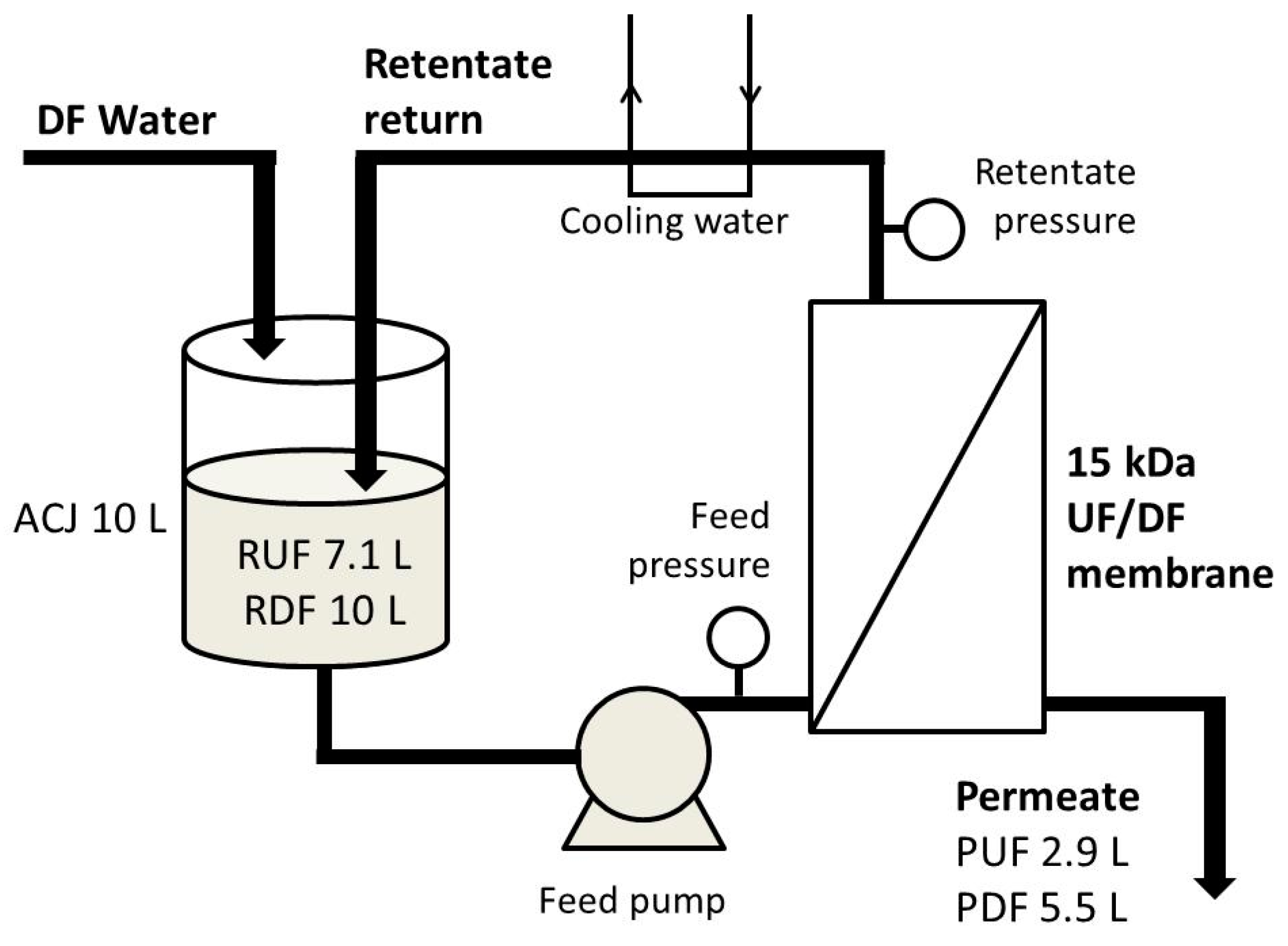
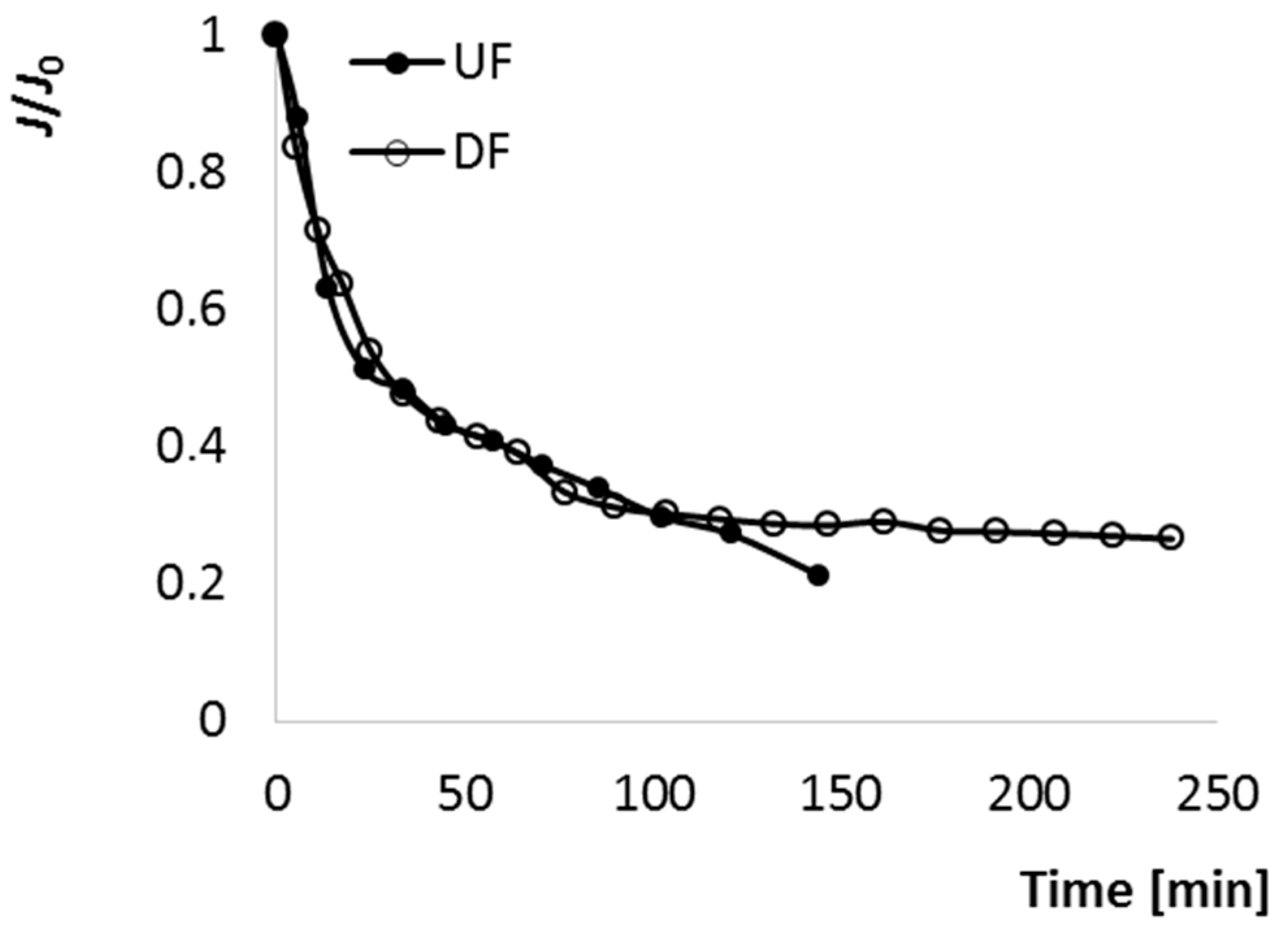
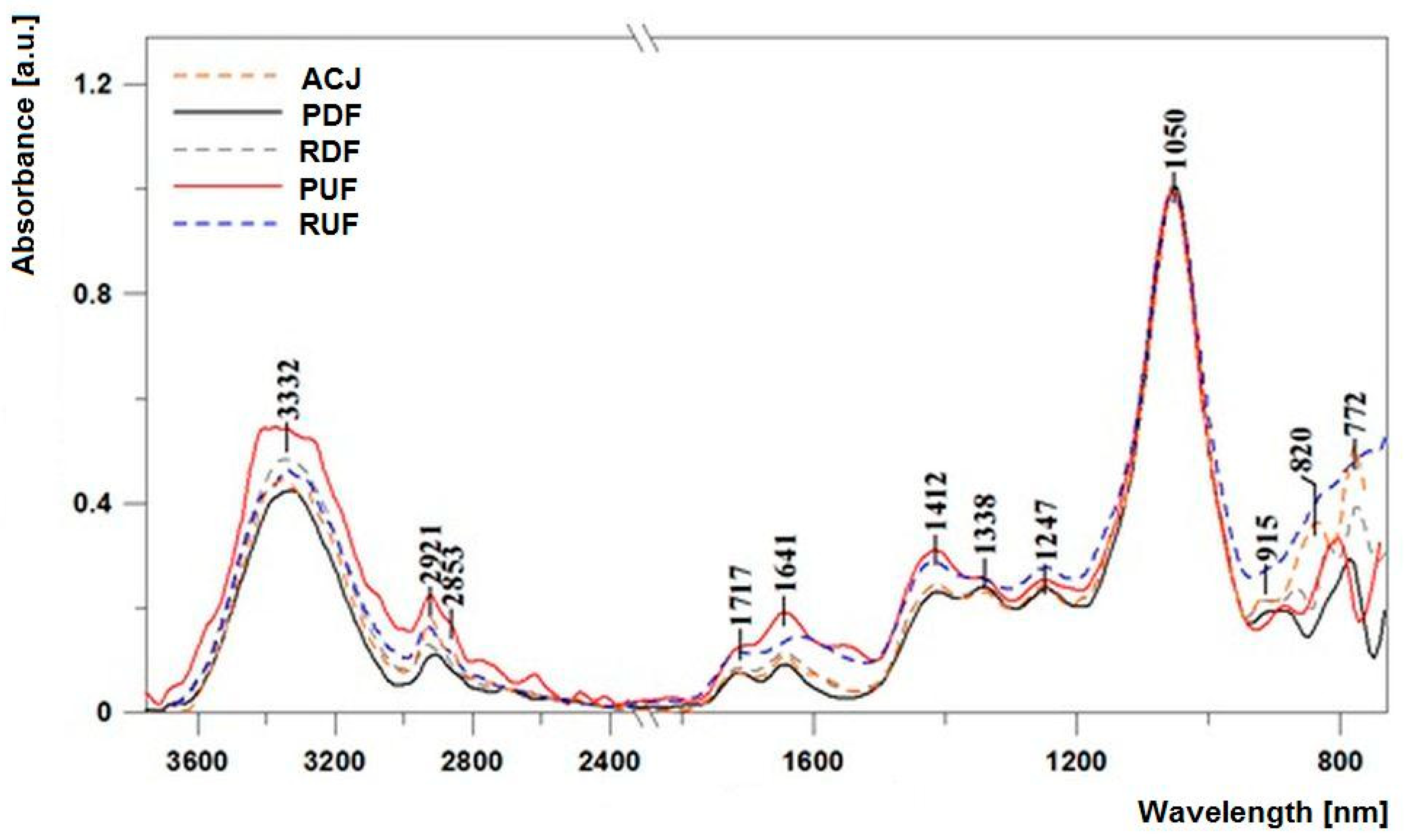
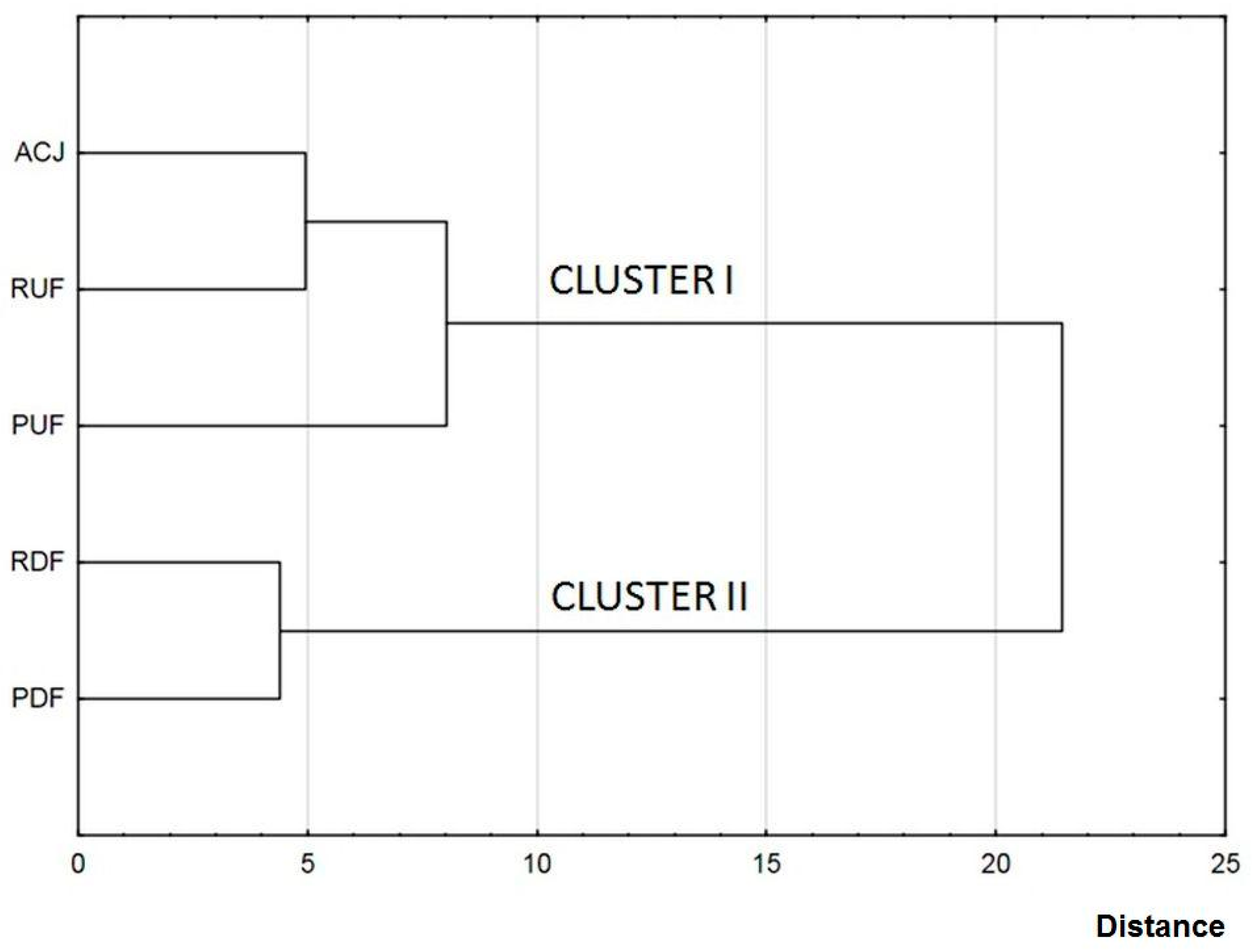

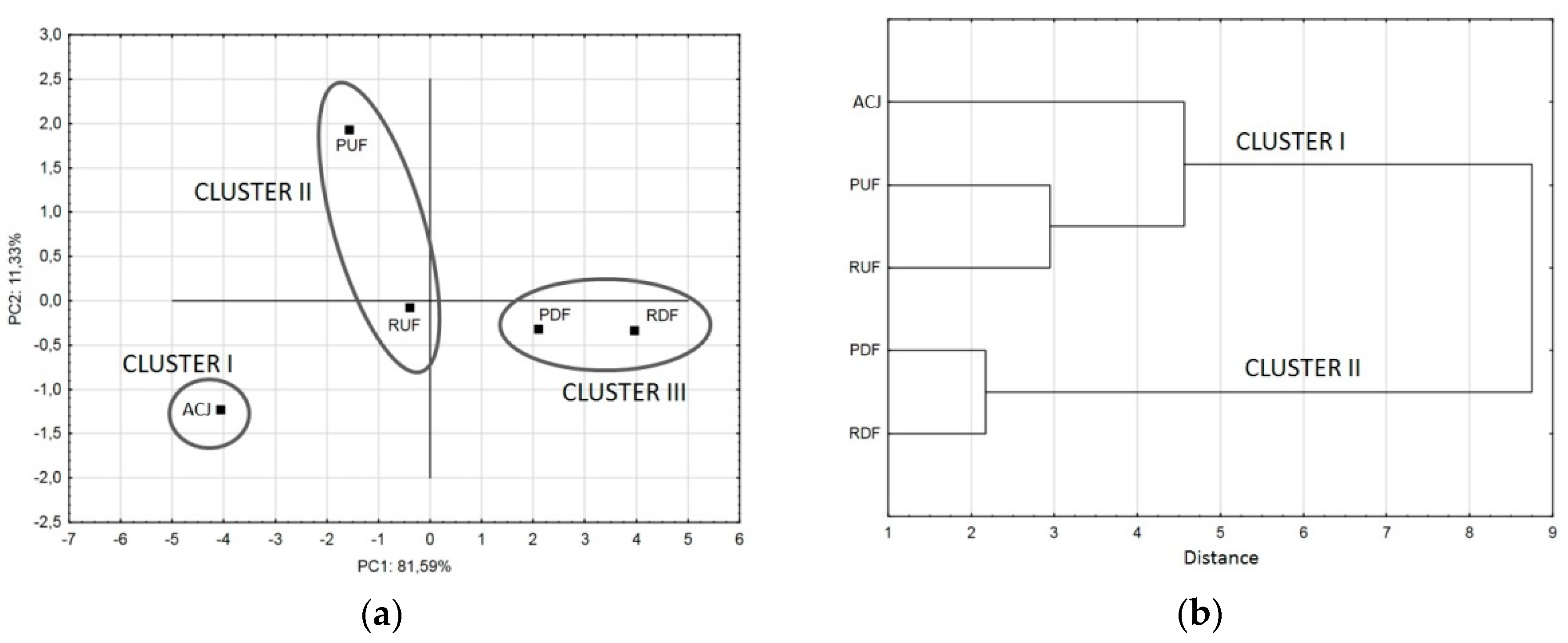
| ACJ | PUF | RUF | RDF | ||
|---|---|---|---|---|---|
| TSS (°Brix) | 12.4 ± 0.0 e | 9.6 ± 0.0 c | 10.4 ± 0.0 d | 6.8 ± 0.0 a | 8.1 ± 0.0 b |
| Glu (g∙100 g−1) | 2.1 ± 0.1 c | 1.6 ± 0.1 b | 1.7 ± 0.1 b | 1.5 ± 0.1 b | 1.2 ± 0.1 a |
| Fru (g∙100 g−1) | 7.0 ± 0.1 d | 5.1 ± 0.1 b | 5.8 ± 0.1 c | 4.7 ± 0.1 b | 3.9 ± 0.1 a |
| TS (g∙100 g−1) | 9.8 ± 0.2 d | 7.3 ± 0.1 bc | 7.5 ± 0.2 c | 6.7 ± 0.2 b | 5.7 ± 0.2 a |
| NSS (%) | 2.6 ± 0.0 c | 2.3 ± 0.0 b | 2.9 ± 0.0 d | 0.1 ± 0.0 a | 2.4 ± 0.0 b |
| D (g∙mL−1) | 1.049 ± 0.000 e | 1.038 ± 0.000 c | 1.041 ± 0.000 d | 1.031 ± 0.000 b | 1.025 ± 0.000 a |
| pH | 3.4 ± 0.0 a | 3.5 ± 0.0 a | 3.5 ± 0.0 a | 3.4 ± 0.0 a | 3.4 ± 0.0 a |
| TA (g∙100 g−1) | 0.7 0 ± 0.01 e | 0.53 ± 0.01 c | 0.57 ± 0.01 d | 0.47 ± 0.01 b | 0.39 ± 0.01 a |
| TPC (mg GA∙100 g−1) | 116.6 ± 3.2 c | 90.1 ± 5.4 ab | 112.5 ± 4.5 c | 85.3 ± 3.5 a | 93.6 ± 2.3 b |
| DPPH (%) | 50.6 ± 2.5 d | 34.8 ± 0.9 b | 43.8 ± 1.9 c | 31.1 ± 1.6 a | 36.6 ± 1.0 b |
| Color parameters L* | 59.9 ± 3.6 a | 93.6 ± 0.1 c | 58.0 ± 1.1 a | 94.5 ± 0.1 c | 63.3 ± 0.1 b |
| a* | 18.4 ± 0.8 c | 6.4 ± 0.1 a | 17.0 ± 0.3 c | 6.1 ± 0.0 a | 13.4 ± 0.1 b |
| b* | 37.1 ± 0.9 d | 12.5 ± 0.1 b | 36.7 ± 0.2 d | 10.1 ± 0.1 a | 31.9 ± 0.1 c |
| ΔE | - | 43.4 ± 0.9 c | 2.3 ± 0.1 a | 44.6 ± 0.8 c | 8.2 ± 0.5 b |
| Position of Bands (cm−1) | Type and Origin of Vibrations | ||||
|---|---|---|---|---|---|
| ACJ | RUF | PUF | RDF | ||
| 3344 | 3345 | 3339 | 3334 | 3344 | ν(–OH) |
| 2917 | 2920 | 2923 | 2916 | 2929 | νas(–C–Hm, –CH3, –CH2) νas(–C–Hvst, –CH2) and νs(–C–Hvst, –CHa) (aliphatic groups) |
| 2857 | 2863 | 2855 | 2855 | 2874 | |
| 2703 | - | - | 2669 | 2707 | (overtone) |
| - | - | 2715 | - | - | |
| 1719 | 1706 | 1707 | 1711 | 1716 | ν(–C=Ost) |
| 1641 | 1616 | 1641 | 1643 | 1643 | ν(–C=O) or δ (O–H) in H2O |
| 1592 | - | - | 1581 | ν (N–H) | |
| - | - | 1457 | - | δ (C–H) in alkenes | |
| 1417 | 1414 | 1415 | 1417 | 142 | |
| 1341 | 1343 | 1340 | 1338 | 1338 | δ (–OH) in C–OH group |
| 1248 | 1243 | 1248 | 1248 | 1246 | ν (C–O) acid stretching |
| 1136 | - | 1134 | 1153 | 1148 | ν (C–O) acid stretching and δ (O–H) deformation of acids |
| 1051 | 1048 | 1051 | 1053 | 1051 | |
| 913 | - | - | 906 | 911 | δ (O–H) deformation of acids, |
| 839 | 837 | 886 | 873 | 868 | ν (C–O) in C–OH group Or ν (C–C) in the carbohydrate structure and δ (C–H) |
| - | 806 | 819 | 823 | ||
| 782 | 775 | 788 | 785 | 777 | |
| TSS | Glu | Fru | TS | TA | TPC | NSS | |
|---|---|---|---|---|---|---|---|
| UF | 76.0 | 76.0 | 77.0 | 77.0 | 76.0 | 76.0 | 72.0 |
| DF | 64.0 | 60.0 | 62.0 | 61.0 | 62.0 | 58.0 | 75.0 |
| ACJ | RUF | RDF | |
|---|---|---|---|
| TS (g·250 mL−1) | 24.5 | 18.8 | 14.3 |
| NSS (g·250 mL−1) | 6.5 | 7.3 | 6.0 |
| %RI | 27.0 | 20.7 | 15.7 |
| TS/NSS | 3.8 | 2.6 | 2.4 |
© 2018 by the authors. Licensee MDPI, Basel, Switzerland. This article is an open access article distributed under the terms and conditions of the Creative Commons Attribution (CC BY) license (http://creativecommons.org/licenses/by/4.0/).
Share and Cite
Samborska, K.; Kamińska, P.; Jedlińska, A.; Matwijczuk, A.; Kamińska-Dwórznicka, A. Membrane Processing in the Sustainable Production of Low-Sugar Apple-Cranberry Cloudy Juice. Appl. Sci. 2018, 8, 1082. https://doi.org/10.3390/app8071082
Samborska K, Kamińska P, Jedlińska A, Matwijczuk A, Kamińska-Dwórznicka A. Membrane Processing in the Sustainable Production of Low-Sugar Apple-Cranberry Cloudy Juice. Applied Sciences. 2018; 8(7):1082. https://doi.org/10.3390/app8071082
Chicago/Turabian StyleSamborska, Katarzyna, Paulina Kamińska, Aleksandra Jedlińska, Arkadiusz Matwijczuk, and Anna Kamińska-Dwórznicka. 2018. "Membrane Processing in the Sustainable Production of Low-Sugar Apple-Cranberry Cloudy Juice" Applied Sciences 8, no. 7: 1082. https://doi.org/10.3390/app8071082
APA StyleSamborska, K., Kamińska, P., Jedlińska, A., Matwijczuk, A., & Kamińska-Dwórznicka, A. (2018). Membrane Processing in the Sustainable Production of Low-Sugar Apple-Cranberry Cloudy Juice. Applied Sciences, 8(7), 1082. https://doi.org/10.3390/app8071082








